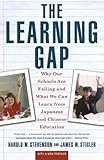The bit about teachers having time to prepare their lessons is one of the key observations of east Asian schools too.
http://www.amazon.com/Learning-Gap-Schools-Japanese-Educatio...
http://www.tc.columbia.edu/lessonstudy/lessonstudy.html
Schools in east Asia have similar staffing ratios (teachers per enrolled pupil) to schools in the United States, but they have MUCH larger class sizes, with teachers having work periods during the day when they review and prepare lessons with colleagues. That makes the teachers more effective, per teacher, and helps the teachers cope with the larger class sizes, because they teach more engaging lessons. When I lived in Taiwan a decade ago, I had a chance to see in a bookstore some Chinese-language books used by teachers to prepare mathematics lessons. They are unlike ANYTHING available in English, much richer in mathematical content and much more filled with sound, practice-based pedagogical tips than comparable books published in the United States.
Because American schools don't try very hard to engage in best practice in teacher coordination for good lesson preparation, and because many United States school textbooks, especially in mathematics, are just plain lousy, I'm able to make a living as a teacher of supplemental mathematics lessons for children who are already attending their free public schools during other days of the week. In this regard, I'd be happy if the system here changed in a way that put me out of my current job.
Another key fact from farther along in the submitted article: "Applicants began flooding teaching programs, not because the salaries were so high but because autonomy and respect made the job attractive." That explains exactly why I teach in the private sector rather than in the government-operated schools of the United States, which hobble the best teachers and coddle the worst in their employ.
Where my wife grew up, it took one teacher to teach 60 pupils. A class size of 50 was an exceptionally small class size. Several of the countries that best the United States in academic achievement
http://timss.bc.edu/PDF/t03_download/T03_M_Chap1.pdf
have much higher class sizes per teacher than the United States has. It is definitely possible to improve teacher productivity over the low level maintained in the United States. There are whole books on the subject.
http://www.amazon.com/Learning-Gap-Schools-Japanese-Educatio...
http://www.amazon.com/Smart-Schools-David-Perkins/dp/0028740...
http://www.amazon.com/Teaching-Gap-Improving-Education-Class...
http://www.amazon.com/Knowing-Teaching-Elementary-Mathematic...


http://www.amazon.com/Vision-Elementary-Mathematics-W-Sawyer...
http://www.amazon.com/Learning-Gap-Schools-Japanese-Educatio...
http://www.amazon.com/Teaching-Gap-Improving-Education-Class...
http://www.amazon.com/Knowing-Teaching-Elementary-Mathematic...
you could learn something new that could help you better understand the other countries in the world and what the United States might learn from them.